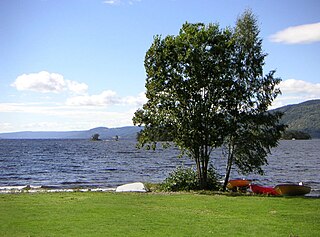
Halfdan the Black was a king of Vestfold. He belonged to the House of Yngling and was the father of Harald Fairhair, the first king of a unified Norway.

Tarjei Vesaas was a Norwegian poet and novelist. Vesaas is widely considered to be one of Norway's greatest writers of the twentieth century and perhaps its most important since World War II.

Randsfjorden is Norway's fourth-largest lake with an area of 140.7 km2 (54.3 sq mi). Its volume is estimated at just over 6.6 km3 (1.6 cu mi), and its greatest depth is 131 m (430 ft). The lake is located at an elevation of 135 m (443 ft) above sea level. It is located in Innlandet and Akershus counties in the municipalities of Gran, Jevnaker, Nordre Land, and Søndre Land in the districts of Land and Hadeland. It is drained by the Randselva river.

Karin Fossum is a Norwegian author of crime fiction, often referred to as the "Norwegian queen of crime".

Johan Falkberget, born Johan Petter Lillebakken, was a Norwegian author. He was nominated for the Nobel Prize in Literature.

Ane Dahl Torp is a Norwegian actress.

Varg Veum is the central character in a series of crime novels, written by the Norwegian author Gunnar Staalesen, about a private detective who lives in Bergen, on the west coast of Norway. The books have been translated into several languages, including English, Spanish, German, and Swedish.

Eva Sletto was a Norwegian actress. She worked at Det Norske Teatret from 1936 to 1983. She is best known for her role as Milja in the film Ungen by Oskar Braaten in 1938, and also played Ismene in Sophocles' Antigone, Titania in Shakespeare's A Midsummer Night's Dream and Olga in Chekhov's Three Sisters. Sletto also played in several movies in the early age of Norwegian cinema. She retired from the stage in 1983, and lived in Oslo until her death at the age of 93.

Haugtussa is an epic circle of poems, written by the Norwegian author Arne Garborg. The poems are reckoned a classical example of Norwegian Neo-romanticism or Symbolism. The themes of the poems are closely related to Garborg's rural background, and a number of supernatural beings, like the draug, the hulderpeople and other creatures, are involved. A Haugtusse is originally a female subterrestrial, but in this story it is an eponym of the main character, a psychic young girl, usually called Veslemøy. In 1900 Garborg published a sequel, I Helheim.

Nini Roll Anker was a Norwegian novelist and playwright. Her books often concerned the lives of women within different social classes as well as the women's rights movement and the rights of the working class.
Finn Øglænd is a Norwegian author, poet, translator and literature critic. He grew up on a small holding at Tananger in Sola municipality.

Hans Jacob Nilsen was a Norwegian actor, theatre director and film director. He was a theatre director at Den Nationale Scene, at Folketeatret, and for two separate periods at Det Norske Teatret.
Dei svarte hestane is a 1951 Norwegian drama film directed by Hans Jacob Nilsen and Sigval Maartmann-Moe, and starring Hans Jacob Nilsen, Eva Sletto and Ottar Vicklund. It is based on the novel Dei svarte hestane by Tarjei Vesaas.

Mette Lange-Nielsen was a Norwegian actress. Her husband was actor Per Lillo-Stenberg, and her son is musician Lars Lillo-Stenberg.
Alf Ramsøy was a Norwegian long-distance runner, cross-country skier, actor and farmer.

Ruth Lillegraven is a Norwegian poet, novelist and children's writer. Her awards include the Brage Prize and the Nynorsk Literature Prize.
Liv Uchermann Selmer was a Norwegian actress.
Roy Bjørnstad was a Norwegian actor.
The Man and the Girl at the Underground Mansion is a Danish folktale collected by theologue Nikolaj Christensen in the 19th century, but published in the 20th century by Danish folklorist Laurits Bodker.
Sigval Maartmann-Moe was a Norwegian film director and screenwriter.













